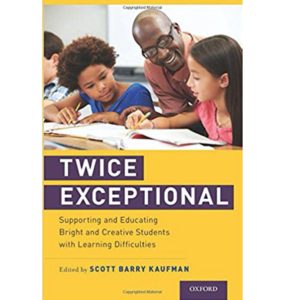 Students who have both exceptional talents and learning difficulties have been understudied and underserved in the educational system. Fortunately, Twice Exceptional: Supporting and Educating Bright and Creative Students with Learning Difficulties helps shed light on this unique and diverse population. This volume contains contributions from over 30 talented scholars and practioners and was edited by Scott Barry Kaufman, who brings a special sensitivity to the topic because of his own experiences as a twice exceptional (2E) student. Kaufman, whose books we have reviewed previously (see here and here) envisions an educational system in which every student receives individualized, challenging, and supportive instruction. Until that dream is realized, it is especially important to provide that kind of individualization to 2E students or students who “demonstrate exceptional levels of capacity, competence, commitment, or creativity in one or more domains coupled with one or more learning difficulties” (P. 7). This book, filled with examples of students with varying 2E profiles, provides guidance about best practices for identifying and supporting 2E students, spotlights specific 2E sub-populations, and concludes with examples of schools that successfully support 2E students.
Students who have both exceptional talents and learning difficulties have been understudied and underserved in the educational system. Fortunately, Twice Exceptional: Supporting and Educating Bright and Creative Students with Learning Difficulties helps shed light on this unique and diverse population. This volume contains contributions from over 30 talented scholars and practioners and was edited by Scott Barry Kaufman, who brings a special sensitivity to the topic because of his own experiences as a twice exceptional (2E) student. Kaufman, whose books we have reviewed previously (see here and here) envisions an educational system in which every student receives individualized, challenging, and supportive instruction. Until that dream is realized, it is especially important to provide that kind of individualization to 2E students or students who “demonstrate exceptional levels of capacity, competence, commitment, or creativity in one or more domains coupled with one or more learning difficulties” (P. 7). This book, filled with examples of students with varying 2E profiles, provides guidance about best practices for identifying and supporting 2E students, spotlights specific 2E sub-populations, and concludes with examples of schools that successfully support 2E students.
Although there is research that recognized 2E students dating back to the 1920s, federal education laws have been slow to do so. In the 1980s there was a shift in gifted education towards recognizing a greater variety of gifts and trying to develop students’ talents rather than assuming that students are either gifted or not. It was not until 2004 that federal disability laws first acknowledged that students with disabilities can also be gifted. Today, parents still face resistance in getting services for 2E children. For example, while 7% of the general student population participates in gifted education, only 1% of students who receive disability services are involved in gifted education.
Contributing to this problem may be difficulties related to defining and assessing both “disability” and “giftedness.’ Additionally, the interacting effects of students’ disabilities and giftedness can contribute to the students’ unique profiles not being recognized. That is one’s exceptionality can hide his disabilities (making adults characterize the student as lazy), one’s disabilities can hide her exceptionalities (making adults underestimate the student’s potential), or one’s disabilities and exceptionalities can each mask the other (making adults miss great potential and great need for support). What 2E students need is to have their unique intersections of exceptionality carefully described and monitored across time and context. Several chapters in this collection provide guidelines for comprehensively assessing students’ learning profiles.
2E students need their strengths, talents, and interests developed. Unfortunately, too much attention is given to compensating for these student’s weaknesses rather than developing their strengths. We should strive to help them reach their fullest potential. We should support students in being assertive self-advocates. When they can advocate for themselves they typically set higher expectations for themselves than others would set for them. Beyond self-advocacy, tending to and developing the social-emotional needs and abilities of 2E students is important for helping them have the resilience to persist through the difficulties they will inevitably face in school. Another key principle for supporting 2E students is creating effective collaboration among family members, teachers, friends, coaches, psychologists, and medical professionals. This book offers several strategies for strengthening the relationship between families and schools.
Several chapters in Twice Exceptional profile certain categories of 2E populations and offer strategies for supporting these populations with a strengths-based approach. For example, attention deficit hyperactive disorder could be reframed as an attention divergent hyperactive gift. Similar ideas are applied to students with autism spectrum disorders, sensory processing issues, and dyslexia or other reading disorders.
One of the most valuable contributions of this book is the focus in two chapters, on an especially underserved 2E sub-population—that of 2E students who are also racial or ethnic minorities. For several problematic reasons, students of color are underrepresented in gifted education. Having other exceptionalities compounds this problem further. To serve 2E students of color it is important to remain flexible, set high expectations, offer role models, and be creative about how to draw out these students’ strengths.
Twice Exceptional concludes by describing real model schools that are designed to support 2E students. These schools celebrate strengths, differentiate curriculum, incorporate social-emotional learning into academic learning, provide a safe space filled with positive peer and teacher relationship, and remain flexible, patient, and optimistic. Above all, they develop autonomy in their students by encouraging the 2E students to assume primary responsibility for shaping their learning.
Kaufman’s Twice Exceptionaloffers a much need consolidation of information about 2E students to raise awareness about this population and help researchers, parents, and educators better serve 2E students.
Kaufman, S. B. (Ed.). (2018). Twice Exceptional: Supporting and Educating Bright and Creative Students with Learning Difficulties. Oxford University Press.



